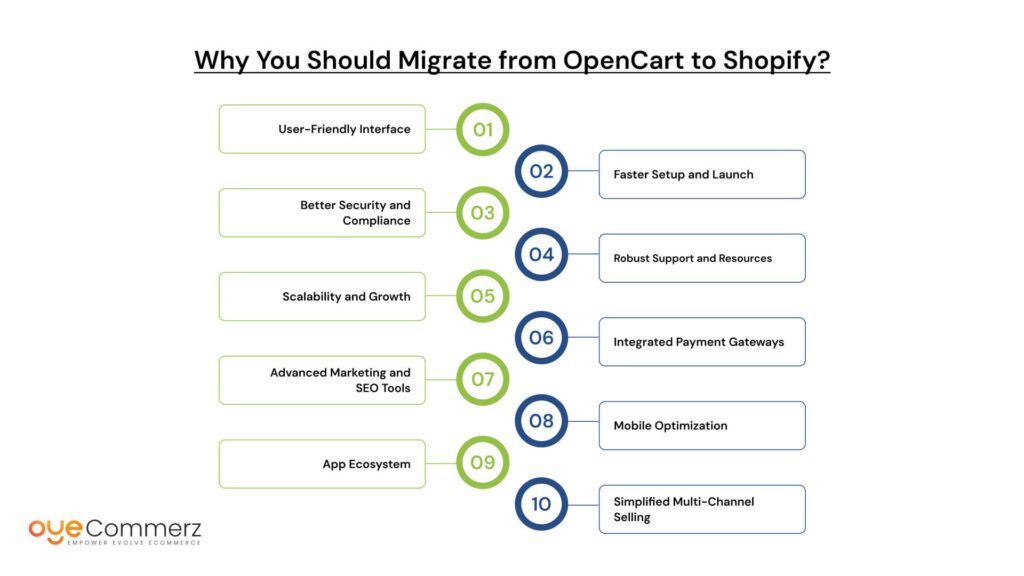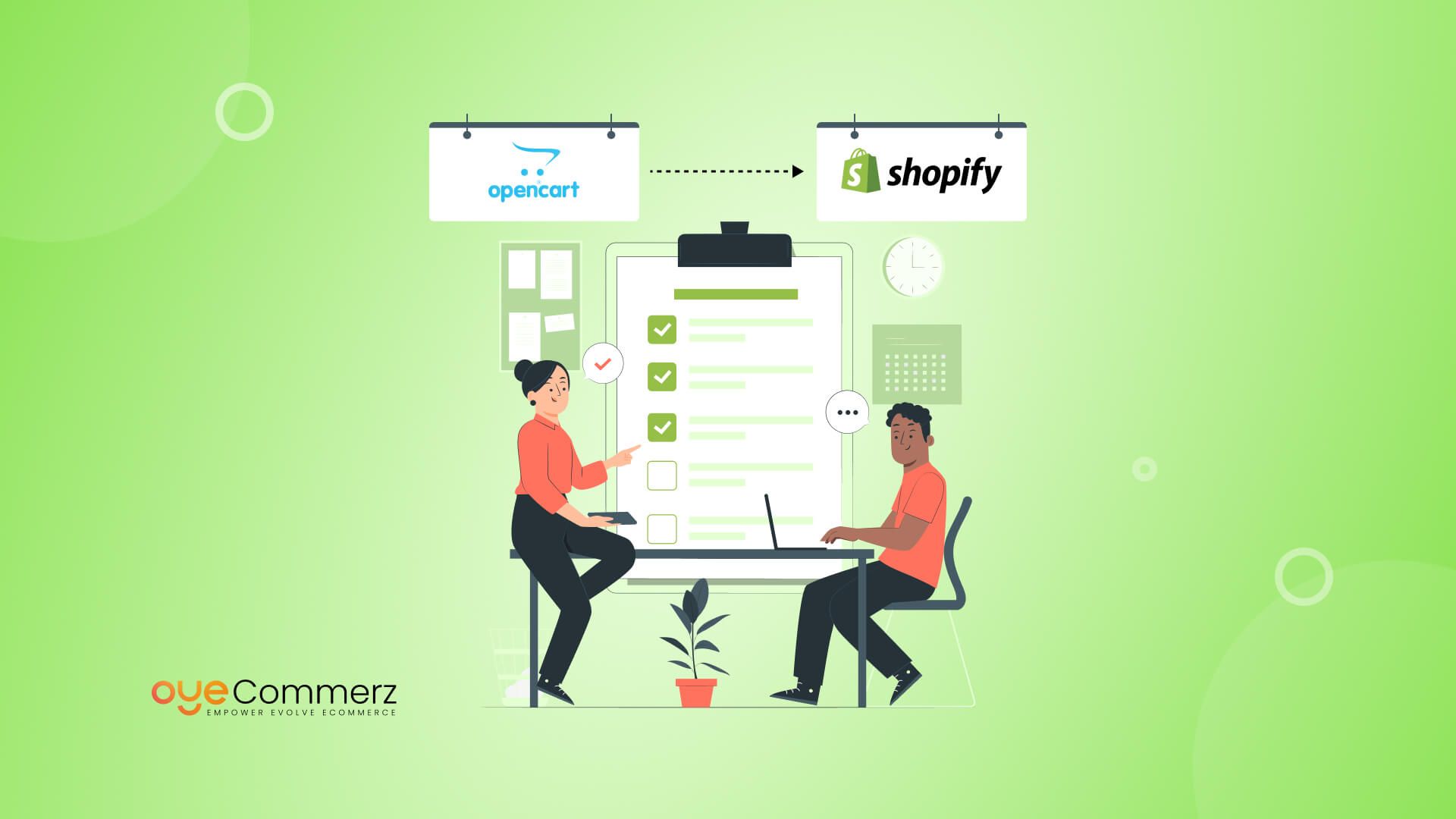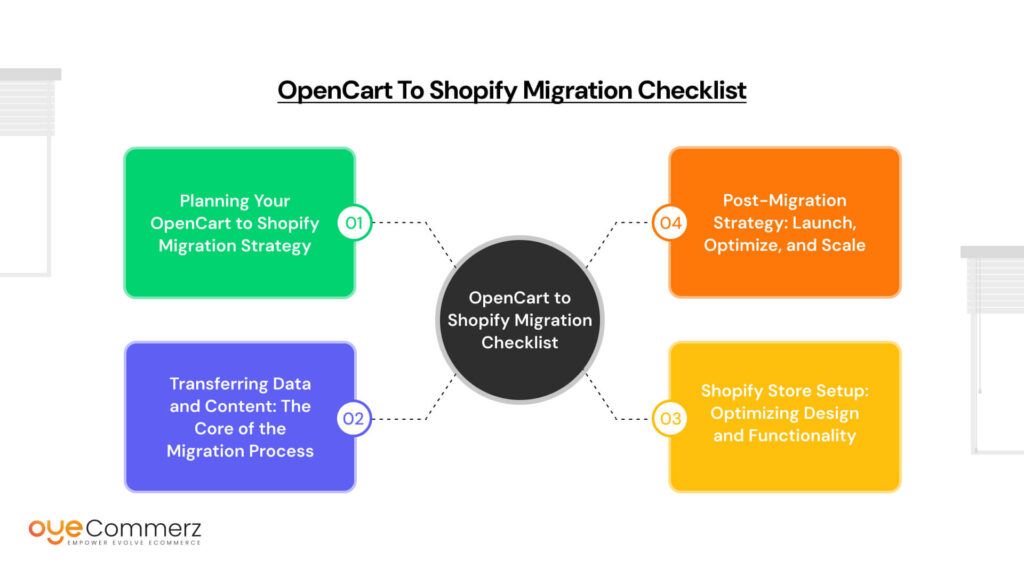Are you an OpenCart user thinking about making the leap to Shopify? If so, you’re probably wondering how to make the migration process as smooth and stress-free as possible. The good news is Many business owners have successfully made the switch, and with the right plan, you can too.
In this guide, we’ll walk you through a simple, easy-to-follow checklist that covers everything from data transfer to design tweaks. By the end of this blog, you’ll have the steps and strategies to ensure a seamless migration and set your business up for success on Shopify. Ready to take the plunge? Let’s dive in!
Table of Contents
ToggleWhy You Should Migrate from OpenCart to Shopify?
Migrating from OpenCart to Shopify can offer a range of advantages that simplify your eCommerce operations and help your business scale more effectively. Here’s why you might consider making the switch:

1. User-Friendly Interface
OpenCart is an open-source platform that requires technical knowledge for management and customization. Shopify, on the other hand, offers an intuitive, user-friendly interface that simplifies store management, even for those with little technical expertise. This means less time spent on managing your store and more time focusing on growing your business.
2. Faster Setup and Launch
Setting up a store on OpenCart often requires a significant amount of development work, particularly when it comes to customizations or adding new features. Shopify’s easy-to-use setup process and pre-designed themes allow you to launch your store quickly, helping you start selling faster.
3. Better Security and Compliance
Security is a major concern for any eCommerce store. Shopify offers built-in security features like SSL encryption and is PCI-compliant, ensuring that your customers’ data is protected. OpenCart requires additional security plugins and manual updates, which can leave your store vulnerable to security risks if not properly maintained.
4. Robust Support and Resources
Shopify provides 24/7 customer support via chat, email, and phone, ensuring that you have help whenever you need it. Additionally, Shopify has a vast knowledge base and active community forums for troubleshooting. In contrast, OpenCart has limited support options, and businesses often have to rely on third-party resources or developers for help.
5. Scalability and Growth
As your business grows, scalability becomes crucial. Shopify is built to scale with your business, handling increased traffic, product catalogs, and sales. OpenCart, while capable, can become cumbersome as your store expands, requiring additional development to scale efficiently.
6. Integrated Payment Gateways
Shopify offers a range of integrated payment gateways, including Shopify Payments, which reduces transaction fees. OpenCart requires manual setup for payment gateway integrations, which can be more complicated and time-consuming.
7. Advanced Marketing and SEO Tools
Shopify comes with built-in tools for SEO, email marketing, and social media integrations, allowing you to reach and engage customers more effectively. OpenCart has some SEO features, but Shopify’s tools are more robust and easy to implement.
8. Mobile Optimization
With mobile shopping on the rise, it’s essential to have a mobile-optimized store. Shopify’s themes are automatically mobile-responsive, ensuring a seamless shopping experience on smartphones and tablets. In OpenCart, mobile optimization requires more customization and may not always deliver the same level of user experience.
9. App Ecosystem
Shopify’s extensive app marketplace offers thousands of apps to extend your store’s functionality—whether it’s advanced analytics, custom shipping, or loyalty programs. OpenCart has a limited selection of extensions, and many require technical knowledge to implement, making Shopify a more flexible option for businesses that need additional features.
10. Simplified Multi-Channel Selling
Shopify makes it easy to sell across multiple channels, including social media platforms, marketplaces, and brick-and-mortar stores, all from one central dashboard. OpenCart supports multi-channel selling, but it requires more manual integration and can be harder to manage.
Migrating from OpenCart to Shopify can streamline your eCommerce operations by offering a more user-friendly platform, enhanced security, faster setup, and better support. Shopify’s scalability, robust app ecosystem, and integrated marketing tools make it an ideal choice for businesses looking to grow without the technical complexity associated with OpenCart. By making the switch to Shopify, you’re investing in a more efficient, secure, and scalable eCommerce solution.
Detailed OpenCart to Shopify Migration Checklist
1. Planning Your OpenCart to Shopify Migration Strategy
Every successful migration begins with a clear strategy. This phase includes analyzing your current eCommerce setup, understanding Shopify’s features, and setting goals for the migration. You’ll need to evaluate how Shopify will support your eCommerce store’s growth, assess the technical details, and allocate resources accordingly.
1.1 Conduct a Comprehensive Site Audit
Before migrating, it’s critical to perform a detailed audit of your current OpenCart store. This will help identify essential elements such as:
- Data to transfer: products, categories, customers, order history, and more
- Extensions and customizations: Check if custom-built extensions and plugins on OpenCart have Shopify equivalents or alternatives.
- Current SEO performance: Analyze your website’s SEO performance to ensure a smooth transfer of meta tags, URLs, and keyword rankings.
A detailed audit will help you identify the scope of work and highlight the areas where your current platform may be limiting your business’s potential. Shopify’s built-in tools and apps, like the Shopify SEO Manager, can help maintain and improve your search rankings during and after the migration process.
1.2 Setting SMART Goals for Migration
Ensure your goals are SMART—Specific, Measurable, Achievable, Relevant, and Time-bound. Some examples of migration goals include:
- Reducing site downtime: Target less than 24 hours of downtime during the switchover.
- Preserving SEO rankings: Maintain 90% of your current organic traffic post-migration.
- Boosting mobile optimization: Ensure your new Shopify store is fully responsive on all mobile devices.
Remember, migrating platforms is not just about transferring data. It’s an opportunity to optimize your website’s design, functionality, and user experience for long-term success.
1.3 Backup All Data
Backing up all the data from your OpenCart store is a critical part of the migration preparation. This backup should include:
- Product information
- Customer data
- Order history
- Reviews
- User accounts and credentials
Make sure you save this data in a secure, accessible location so that it can be retrieved easily if needed. For data-heavy businesses, consider using Shopify Plus, which offers greater flexibility and customization options during data migration.
2. Transferring Data and Content: The Core of the Migration Process
Data transfer is the core part of your OpenCart to Shopify migration checklist. This process involves moving critical information such as product catalogs, customer data, and SEO elements to your new Shopify store without disrupting day-to-day business operations. With Shopify’s advanced data migration tools, the transfer process becomes more efficient and less prone to errors.
2.1 Migrating Product Catalogs and Categories
The product catalog is the heart of any eCommerce business. In this stage, you’ll be transferring:
- Product names, descriptions, images, and prices
- Product categories and subcategories
- Inventory levels
To ensure data accuracy, use a dedicated migration tool like LitExtension or Cart2Cart, which can facilitate seamless bulk transfers. Ensure that you keep all product URLs intact by using 301 redirects to prevent losing valuable organic traffic.
2.2 Customer Data and Order History Transfer
Maintaining a seamless experience for existing customers is key to a successful migration. Shopify allows the migration of customer data, such as:
- Customer accounts
- Order history
- Customer loyalty points and wishlists (if applicable)
Make sure that customer passwords are securely encrypted. Shopify can help guide the re-encryption process to ensure that the customers can easily log back in post-migration.
2.3 SEO Migration and URL Redirects
One of the most critical elements of migration is retaining your SEO rankings. Migrating your store without taking care of SEO elements can result in a significant drop in traffic. Here’s what you need to do:
- Transfer meta titles and descriptions for each product page
- Set up 301 redirects to map OpenCart URLs to Shopify URLs
- Check that schema markup for rich snippets is properly transferred
Shopify’s SEO capabilities are robust and come with built-in optimization tools. Shopify also offers integrations with Google Search Console and SEO apps to monitor and optimize your site’s performance after migration.
3. Shopify Store Setup: Optimizing Design and Functionality
Once your data is transferred, the next step is to set up and optimize your Shopify store. This is where you’ll ensure that your new store design reflects your brand identity and offers an improved customer experience.
3.1 Choosing the Right Shopify Theme
Shopify offers hundreds of customizable themes, which can help create a seamless shopping experience. When selecting a theme, consider:
- Mobile responsiveness: Over 60% of eCommerce traffic now comes from mobile devices, so a mobile-friendly theme is essential .
- Customizability: Choose a theme that aligns with your brand and offers flexible design options.
- Performance: Ensure the theme is optimized for fast loading times, as page speed directly impacts SEO and customer satisfaction.
For enterprise-level eCommerce businesses, Shopify Plus offers advanced theme customizations and more control over the storefront design.
3.2 Adding Essential Shopify Apps and Integrations
One of the advantages of Shopify over OpenCart is the availability of thousands of apps and integrations. Some essential Shopify apps include:
- Inventory management: Tools like Stocky help track inventory levels across multiple sales channels.
- Shipping solutions: Shopify integrates with leading logistics providers like FedEx and UPS, offering real-time shipping rates and fulfillment options.
- Payment gateways: Shopify supports over 100 payment gateways, including Shopify Payments, which eliminates transaction fees and streamlines the checkout process.
3.3 Testing the New Shopify Store
Before making the switch from OpenCart to Shopify, perform a series of tests to ensure the functionality of the new store. Focus on:
- Checkout process: Test for seamless functionality from cart to checkout.
- Responsive design: Test the store across all device types to ensure a uniform experience.
- Loading speeds: Use tools like Google PageSpeed Insights to ensure your new store meets performance benchmarks.
Once you’ve conducted thorough testing and ensured everything is functioning correctly, you’ll be ready to launch your new Shopify store.
4. Post-Migration Strategy: Launch, Optimize, and Scale
Once the migration is complete, your work doesn’t stop. A post-migration strategy is vital to ensure everything runs smoothly on your new Shopify platform and to optimize for growth.
4.1 Monitoring Performance and Fixing Issues
In the first few weeks after migration, keep a close eye on site performance and address any issues immediately. Pay attention to:
- Traffic and SEO performance: Use tools like Google Analytics and Shopify Analytics to monitor traffic and ensure there are no drops.
- Customer experience: Gather customer feedback on the new store and fix any issues with the user experience.
- Site speed: Continue optimizing site performance to keep page load times under three seconds, which is a crucial factor for SEO and user retention.
4.2 Ongoing SEO Optimization
SEO is an ongoing process, and after migration, it’s essential to continue optimizing. Focus on:
- Content optimization: Regularly update product descriptions and blog posts to reflect relevant keywords.
- Backlinking: Build a strong backlink profile to boost your domain authority.
- Local SEO: If applicable, optimize for local searches by claiming your Google My Business profile.
4.3 Scaling Your Business with Shopify Plus
For enterprise-level businesses, Shopify Plus offers advanced features such as Shopify Scripts, allowing you to customize the checkout process and automate repetitive tasks. Shopify Flow is another essential tool for large eCommerce businesses, automating complex workflows without the need for custom coding.
Shopify Plus also offers a higher level of support and dedicated account management, ensuring your business can continue to scale without performance bottlenecks.
Seamlessly Migrate from OpenCart to Shopify with Oyecommerz
At Oyecommerz, we specialize in helping businesses of all sizes whether small or enterprise migrate to Shopify smoothly and efficiently. Our team ensures a seamless transition with expert data transfer, custom Shopify theme development, and SEO-focused migration to keep your store thriving.
Let us take the hassle out of your migration and set your business up for growth on Shopify. Contact Oyecommerz today and let’s build a powerful, future-ready Shopify store together!
Contact to Migrate your Site to Shopify Now
Conclusion
Migrating from OpenCart to Shopify can transform your business by unlocking new growth opportunities and improving the customer experience. By following this detailed OpenCart to shopify migration checklist, you can ensure a smooth and successful transition. With the power of Shopify’s advanced features, mobile optimized designs, and scalable infrastructure, your eCommerce store is well-positioned for long-term success.
Oyecommerz, a trusted Shopify Plus development agency, specializes in guiding enterprise businesses through seamless migrations. Contact our experts today to discuss how we can help you achieve a successful OpenCart to Shopify migration tailored to your business’s unique needs.





